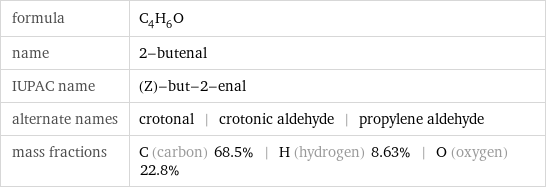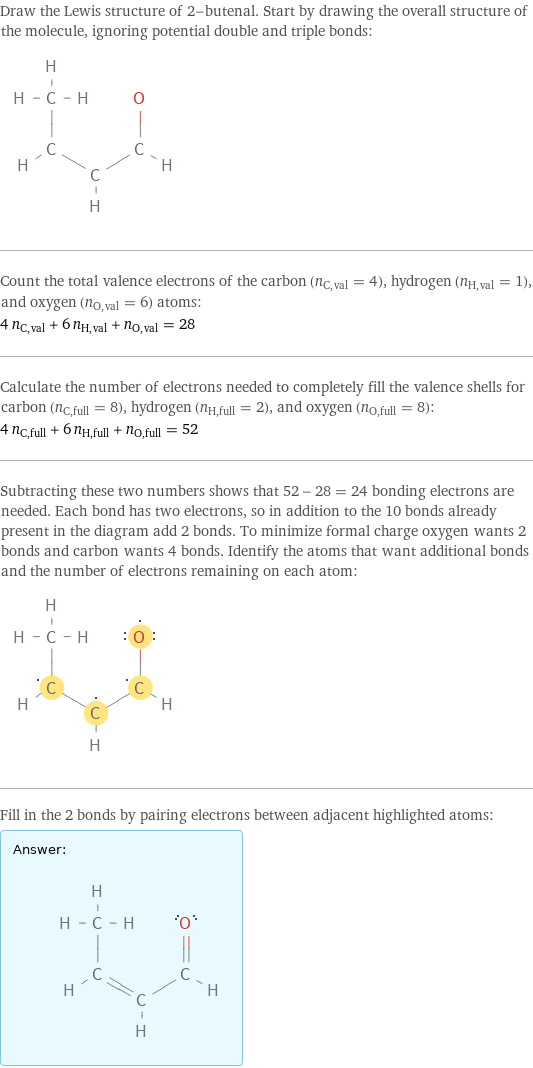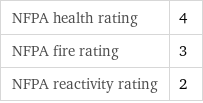Input interpretation

2-butenal
Chemical names and formulas

formula | C_4H_6O name | 2-butenal IUPAC name | (Z)-but-2-enal alternate names | crotonal | crotonic aldehyde | propylene aldehyde mass fractions | C (carbon) 68.5% | H (hydrogen) 8.63% | O (oxygen) 22.8%
Lewis structure

Draw the Lewis structure of 2-butenal. Start by drawing the overall structure of the molecule, ignoring potential double and triple bonds: Count the total valence electrons of the carbon (n_C, val = 4), hydrogen (n_H, val = 1), and oxygen (n_O, val = 6) atoms: 4 n_C, val + 6 n_H, val + n_O, val = 28 Calculate the number of electrons needed to completely fill the valence shells for carbon (n_C, full = 8), hydrogen (n_H, full = 2), and oxygen (n_O, full = 8): 4 n_C, full + 6 n_H, full + n_O, full = 52 Subtracting these two numbers shows that 52 - 28 = 24 bonding electrons are needed. Each bond has two electrons, so in addition to the 10 bonds already present in the diagram add 2 bonds. To minimize formal charge oxygen wants 2 bonds and carbon wants 4 bonds. Identify the atoms that want additional bonds and the number of electrons remaining on each atom: Fill in the 2 bonds by pairing electrons between adjacent highlighted atoms: Answer: | |
3D structure

3D structure
Basic properties

molar mass | 70.09 g/mol phase | liquid (at STP) melting point | -74 °C boiling point | 102 °C density | 0.858 g/cm^3
Units

Hydrophobicity and permeability properties

predicted LogP hydrophobicity | 0.88 predicted LogS | -0.02
Basic drug properties

approval status | experimental | small molecule
Liquid properties (at STP)

density | 0.858 g/cm^3 vapor pressure | 31 mmHg (at 25 °C) refractive index | 1.4384
Units

Thermodynamic properties

molar heat of vaporization | 38.9 kJ/mol specific heat of vaporization | 0.555 kJ/g molar heat of combustion | 2268 kJ/mol specific heat of combustion | 32.36 kJ/g critical temperature | 568 K critical pressure | 4.4 MPa (at STP)
Chemical identifiers

CAS number | 4170-30-3 Beilstein number | 906731 PubChem CID number | 643950 PubChem SID number | 7886769 SMILES identifier | CC=CC=O InChI identifier | InChI=1/C4H6O/c1-2-3-4-5/h2-4H, 1H3/b3-2- InChI key | MLUCVPSAIODCQM-NSCUHMNNBQ EU number | 224-030-0 RTECS number | GP9499000 NSC number | 56354
NFPA label

NFPA label

NFPA health rating | 4 NFPA fire rating | 3 NFPA reactivity rating | 2
Safety properties

flash point | 13 °C autoignition point | 115 °C lower explosive limit | 2.1% (concentration in air) upper explosive limit | 15.5% (concentration in air)

DOT hazard class | 6.1 DOT numbers | 1143
Toxicity properties

RTECS classes | tumorigen | mutagen